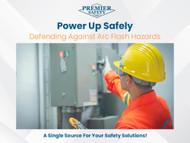Power Up Safely: Defending Against Arc Flash Hazards
Posted by Michael Womack - Premier Safety on May 22nd 2023

Power Up Safely: Defending Against Arc Flash Hazards
Welcome to our blog post dedicated to shedding light on the critical topic of arc flash hazards. By increasing awareness and implementing preventive measures, we can protect workers in industries prone to these incidents.
This article will examine what it is and what causes it. We will also discuss the industry’s most at risk and prevention strategies. We will explore the importance of arc flash labels. We will also discuss the need for proper personal protective equipment (PPE) to protect against arc flash hazards.
Prioritize Safety
Arc flash awareness is a cornerstone of workplace safety. Educating workers about the risks helps them understand potential hazards. This enables them to take preventive actions.
People are becoming more aware of safety protocols. This encourages a culture of safety, so employees understand the importance of following safety rules and wearing the right protective equipment. Through ongoing training and communication, we can promote a collective commitment to preventing electrical hazards.
What is Arc Flash?
Arc flash is the sudden release of electricity. It happens when air between conductors breaks down. This release generates intense heat, light, and pressure waves, posing significant risks to workers. Incidents can result in severe burns, injuries, and even fatalities.
Identifying The Triggers
Arc flash incidents can be triggered by various factors, including accidental contact, equipment failure, improper maintenance, or environmental conditions. Understanding these causes is crucial in implementing preventive measures. We can significantly reduce the risk of incidents and protect workers from harm by taking preventative measures. These measures include addressing potential triggers, conducting regular equipment inspections, and fostering a culture of safety.
Most Vulnerable Industries
While arc flash incidents can occur in various industries, certain sectors are particularly susceptible. Industries like electrical utilities, manufacturing, construction, oil and gas, and data centers often use high-voltage equipment and complex electrical systems. This increases the chance of arc flash incidents occurring.
Employers and workers in these industries must prioritize electrical safety. They must also undergo specialized training and follow industry-specific guidelines to reduce arc flash risks.
Preventing Hazards: Proactive Strategies
Prevention is paramount in reducing arc flash hazards. Employers should conduct thorough arc flash risk assessments to identify potential hazards and establish appropriate safety protocols. This includes regular equipment maintenance, routine inspections, and adherence to industry standards such as NFPA 70E.
Implementing engineering controls, such as current-limiting devices and arc-resistant equipment, can further enhance safety. Additionally, comprehensive worker training programs should emphasize hazard recognition, safe work practices, and the correct use of personal protective equipment (PPE).
Labels That Communicate Hazards
Arc flash labels play a vital role in effectively communicating the potential hazards associated with electrical equipment. These labels provide critical information such as arc flash boundaries, incident energy levels, and required PPE. Ensuring clear and prominently displayed labels enables workers to understand the risks involved and take appropriate safety precautions. Employers should prioritize the accurate labeling of equipment to enhance safety awareness and facilitate informed decision-making.
Proper PPE
Personal protective equipment (PPE) is essential in safeguarding workers from arc blast hazards. It should include flame-resistant clothing, face shields, safety glasses, gloves, and other appropriate gear to minimize the risk of injuries.
It is crucial to select PPE that meets industry standards and provides adequate protection against arc flash incidents. Employers must ensure proper training on PPE usage, maintenance, and inspection. Regular assessments of PPE effectiveness should also be conducted to guarantee workers' safety.
Conclusion
Arc flash incidents can be dangerous in many sectors. To reduce their occurrence and protect employees, we must create awareness, take preventive actions, and prioritize safety. Arc flash awareness programs can help us understand the causes of arc flash incidents. We can also reduce the likelihood and impact of these incidents by implementing proactive strategies.
Clear arc flash labels and the use of proper personal protective equipment (PPE) further enhance safety. We can create a safer work environment by working together. Promoting a culture of safety and following preventive measures can safeguard against arc flash incidents. Remember, these actions are essential for safety.

